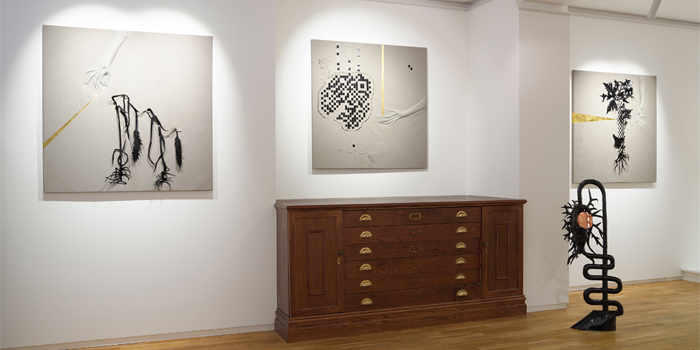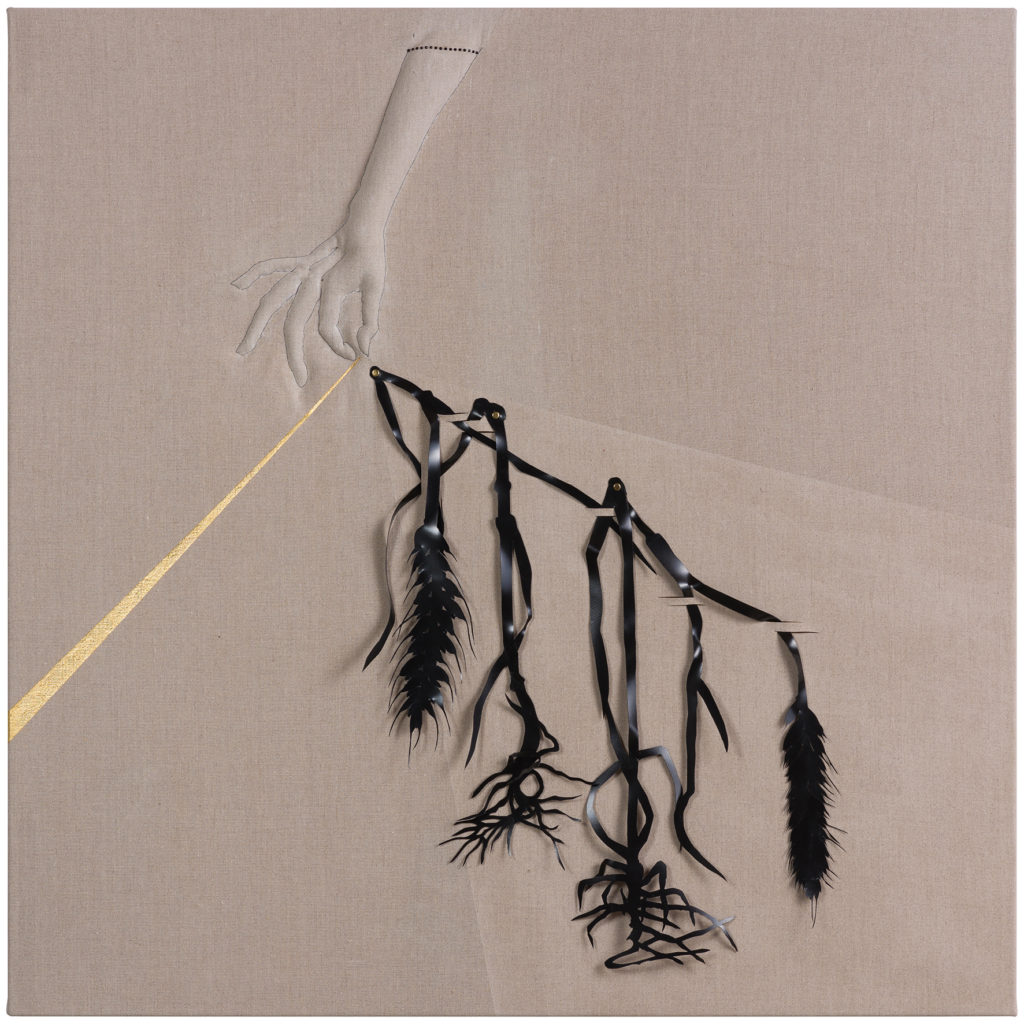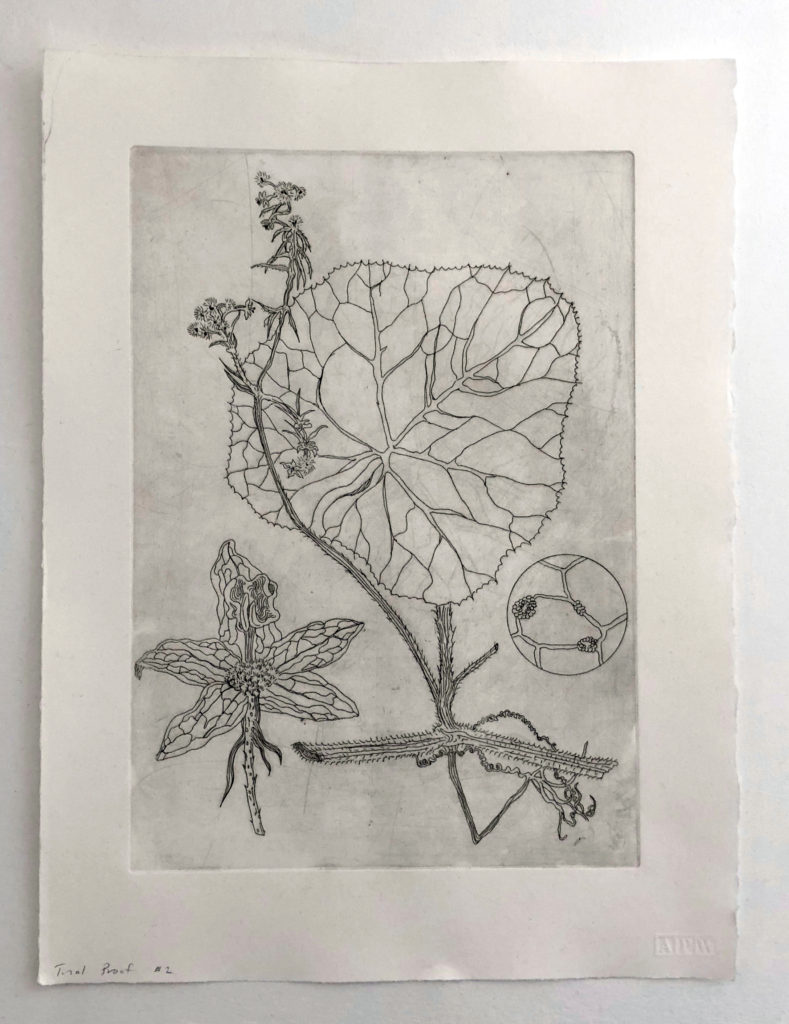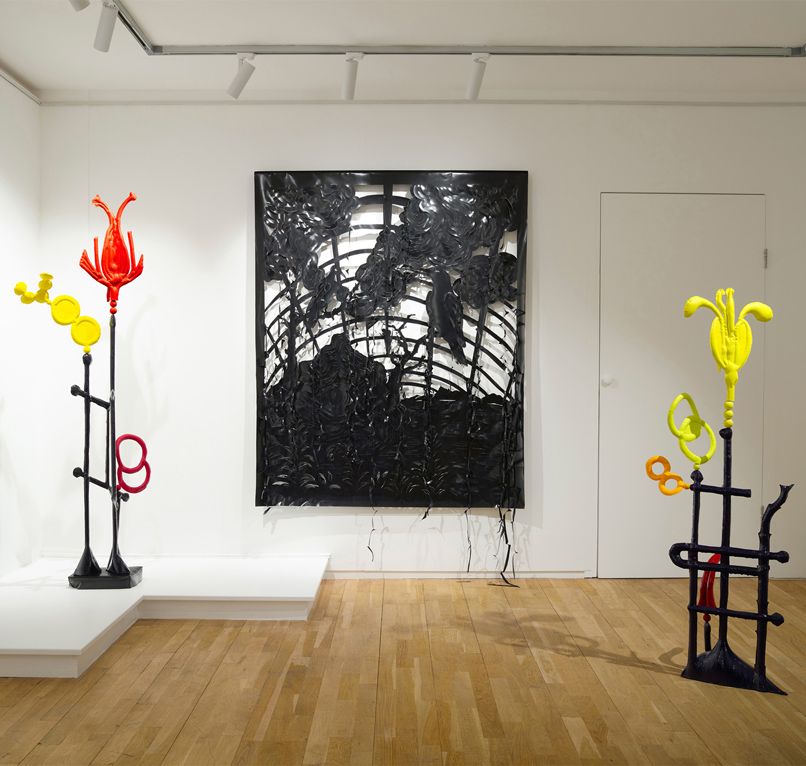Ex Situ





Photography: Peter Mallet
Ex Situ In Situ
Nina Miall, Curator
In Ex Situ, artist Caroline Rothwell assembles an imaginary botanical archive. Drawing on the materials and instruments of 19th-century botany, mediated by the technological revolution of the 20th century, the new sculptural works in this exhibition offer a visual register of humanity’s impact on the natural world today.
The body of work presented in Ex Situ grows out of a residency Rothwell undertook at the Museum of Archaeology and Anthropology at the University of Cambridge in 2015, where she encountered rare botanical specimens held in the university’s herbarium. Some of these samples, such as a now-extinct cucumber found by Charles Darwin in the Galapagos Islands, have been hybridised by the artist in the ‘Arrangement’ series. Black silhouettes of these specimens, alongside others sourced by English naturalist Joseph Banks and Soviet agronomist Nikolai Vavilov, are hand-cut from industrial PVC and threaded through raw Belgian linen. Cast in relief, a disembodied female hand appears poised to either pluck or plant the botanical hybrid in each work, engaged, like the artist, in an act of re-germination. Geometric applications of gold leaf evoke historical scientific instruments, while fictitious barcodes created by the interwoven linen and PVC suggest the evolution of nature in the digital age.
Vivid and contemporary in their materiality, these new wall mounted works are offered as honorary arrangements for the various naturalists who inspired them (Darwin, Banks, Vavilov). Harnessing the ecological potential of centuries-old preserved plants, they convey the adaptive resilience of nature set against global histories of trade, industrialization and colonisation.
‘Biomorphs’, a series of freestanding sculptures in vivid colours, conducts a similar enquiry into ideas of classification and control, nature and artifice, evolution and transmutation. Created from hydrostone, poured into stitched canvas and laminated in epoxy resin, these pieces invoke the museological treatment of taxidermied objects but with a distinctly artificial or unnatural aesthetic. Organic and industrial forms are juxtaposed in elongated, vertical configurations which stress their contemporary interdependency. Plant stems morph into convoluted networks of copper pipes or grow out of stainless steel drains in which unknown substances pool. Around these botanical forms are propped high-gloss human tongues or microscopic lenses, suggesting a radical new taxonomy by which to understand today’s genetically and technologically modified plant forms.
The ‘Arrangement’ and ‘Biomorphs’ sculptures reveal an artist regenerating botanical specimens from the past, cultivating them through the technological advances of the 20th century, to speculate on their environmental potential for a post-industrial age. Based on the principles of ex situ conservation, in which an endangered plant species is offered protection outside its natural habitat, Rothwell’s imaginary archive considers how our innate biophiliac tendencies to collect, understand, modify and disrupt the natural world have shaped our engagement with it across centuries.
In the precarious equilibrium that exists between natural and manmade systems in Rothwell’s works is a formal reckoning of the environmental consequences of human endeavour in the age of the Anthropocene.
Plant Matters
Professor Nicholas Thomas
Director, Museum of Archaeology and Anthropology, University of Cambridge
Botany might be considered as a specific discipline, the province of scientists and students, but it has long been much more: an undisciplined realm in which inquiry, illustration, imagination and metaphor energize each other. Botanical knowledge is part of humanity’s history: Indigenous foragers, early horticulturalists, merchants and makers have all had to understand plants, their seasonality, their life cycles, their food value and the material qualities of woods and dyes have been known intimately, but from different perspectives, across epochs and continents. In the modern period, botany becomes vital, a task of the traveller and of the explorer, a cultural realm intimately associated with empire.
Scientists such as Joseph Banks were at once cosmopolitans and patriots. Their natural community of correspondence was European: Linnaeus and his followers wrote eagerly, read widely and crossed borders to visit collections, between Stockholm, Halle, Heidelberg, Montpellier, Paris, London, Madrid and elsewhere. On the other hand, Banks, like his mentor Phillip Miller of the Chelsea Physic Garden, was passionately interested in the scope for transplanting useful species between regions and nations, in particular for the benefit of his countrymen. One such endeavour, to take breadfruit from Tahiti to the West Indies, where it would provide cheaper food for slaves on British plantations, resulted in the most notorious mutiny in world history.
The culture of botany has extended across boundaries and binaries of all kinds. Both scientific and aesthetic, domestic and colonial, academic and commercial, it embraced both masculine field exploration and forms of illustration to which many women dedicated themselves. They included the extraordinary, scientifically-precise paper collages of Mary Delaney, the famous eighteenth-century bluestocking.
Caroline Rothwell’s botanical works are the outcome of sustained engagement with botanical collections, in Cambridge and elsewhere. At the time she studied the plant specimens collected by Charles Darwin, in the University’s Herbarium, she was affiliated with the Museum of Archaeology and Anthropology, a major ethnographic collection in which artefacts associated with voyages to the Pacific and Australia, dating back to those of Captain James Cook, loom large. A large proportion of MAA’s collection is made of wood, leaf, bark, seeds and plant fibres of all kinds; it is not a botanical collection but a collection in which the botanical world is mediated by the lives of people from all over the world, and the practice of thousands of individual makers: sculptors, weavers of baskets, beaters and painters of barkcloth among them.
In the presence of Caroline Rothwell’s works, I am struck by the strange fashion in which botanical art has for so long been at once embodied and disembodied. In Linnean visualisations, plants are cut up and apart. Yet such images were also sensual, tending toward the fleshy. In some works, the women’s hands are poised, ready to either pluck or re-plant vibrant new expressions of archival specimens, further instantiating a process in which the natural and the artificial, the historical and the contemporary feed on each other and evolve. That evolution was once understood as improvement. Now it appears uncontrolled and uncontrollable. Caroline Rothwell’s plants are bright, disturbing, perhaps invasive, certainly fertile.